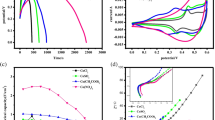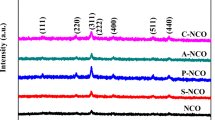Abstract
CoMoO4 material has great advantages in the application of supercapacitors, but the low conductivity and reactivity of CoMoO4 limit its capacity and energy density severely, resulting in a certain gap between the actual value and the theoretical value of specific capacitance. As an electrode material, the performance of CoMoO4 electrode material with spinel structure is directly related to the microstructure of the material. In this paper, CoMoO4 material grown in situ on nickel foam was synthesized by hydrothermal method. Through electrochemical performance tests, the best electrochemical performance belong to the materials using ammonium molybdate and cobalt nitrate as raw materials, synthesized at hydrothermal temperature of 140 °C for 10 h, and calcined at 250 °C for 1 h. The discharge capacity of the material is up to 11.112 F/cm2 at the current density of 3 mA/cm2. The XRD characterization shows that the material has good crystallinity, and it belongs to the orthorhombic structure. The SEM characterization shows that the synthesized material is in cuboid rod structure with loose folds on the periphery. According to EDS analysis, the atomic proportion of each element is close to that in the molecular formula. The positions of absorption peaks in the infrared spectrum are consistent with that of CoMoO4 material.













Similar content being viewed by others
Data availability
No data, models, or code were generated or used during the study.
References
X. Yang, C. Xiang, Y. Zou et al., Low-temperature synthesis of sea urchin-like Co–Ni oxide on graphene oxide for supercapacitor electrodes. J. Mater. Sci. Technol. 55, 223–230 (2020)
Y. Xuemin, L. Hejun, Y. Ruimei et al., NiCoLDH nanosheets grown on MOF-derived Co3O4 triangle nanosheet arrays for high-performance supercapacitor. J. Mater. Sci. Technol. 62, 60–69 (2021)
Z. Wang, J. Chang, L. Chen et al., Al doped Co hydroxyl fluoride nanosheets arrays as efficient faradaic electrode for hybrid supercapacitor. Electrochim. Acta 323, 134815 (2019)
B. Xu, Y. Sun, Z. Chen et al., Facile and large-scale preparation of Co/Ni-MoO2 composite as high-performance electrocatalyst for hydrogen evolution reaction. Int. J. Hydrogen Energy 43(45), 20721–20726 (2018)
J. Deng, H. Li, S. Wang et al., Multiscale structural and electronic control of molybdenum disulfide foam for highly efficient hydrogen production. Nat. Commun. 8(1), 1–8 (2017)
I.S. Altarawneh, S.E. Rawadieh, M.A. Batiha et al., Structures and thermodynamic stability of cobalt molybdenum oxide (CoMoO4-II). Surf. Sci. 677, 52–59 (2018)
D.D. Sarma, C.N.R. Rao, XPES studies of oxides of second-and third-row transition metals including rare earths. J. Electron Spectrosc. Relat. Phenom. 20(1), 25–45 (1980)
G.W. Smith, J.A. Ibers, The crystal structure of cobalt molybdate CoMoO4. Acta Crystallogr. A 19(2), 269–275 (1965)
G.W. Smith, The crystal structures of cobalt molybdate CoMoO4 and nickel molybdate NiMoO4. Acta Crystallogr. A 15(10), 1054–1057 (1962)
S.W. Kim, D.H. Seo, X. Ma et al., Electrode materials for rechargeable sodium-ion batteries: potential alternatives to current lithium-ion batteries. Adv. Energy Mater. 2(7), 710–721 (2012)
B. Wang, S. Li, X. Wu et al., Self-assembly of ultrathin mesoporous CoMoO4 nanosheet networks on flexible carbon fabric as a binder-free anode for lithium-ion batteries. New J. Chem. 40(3), 2259–2267 (2016)
D. Guo, P. Zhang, H. Zhang et al., NiMoO4 nanowires supported on Ni foam as novel advanced electrodes for supercapacitors. J. Mater. Chem. A 1(32), 9024–9027 (2013)
X. Song, X. Ma, Y. Li et al., Tea waste derived microporous active carbon with enhanced double-layer supercapacitor behaviors. Appl. Surf. Sci. 487, 189–197 (2019)
L. Jinlong, Y. Meng, K. Suzuki et al., Synthesis of CoMoO4@ RGO nanocomposites as high-performance supercapacitor electrodes. Microporous Mesoporous Mater. 242, 264–270 (2017)
J. Li, C. Zhao, Y. Yang et al., Synthesis of monodispersed CoMoO4 nanoclusters on the ordered mesoporous carbons for environment-friendly supercapacitors. J. Alloy. Compd. 810, 151841 (2019)
X. Cui, X. Chen, W. Zhang et al., Developing a facile method to construct 3D hierarchical CoMoO4@C@MnO2 core-shell structure aligned on Ni foam with enhanced pseudocapacitive performances. J. Alloy. Compd. 695, 2109–2116 (2017)
J. Yao, Y. Gong, S. Yang et al., CoMoO4 nanoparticles anchored on reduced graphene oxide nanocomposites as anodes for long-life lithium-ion batteries. ACS Appl. Mater. Interfaces 6(22), 20414–20422 (2014)
X.C. Dong, H. Xu, X.W. Wang et al., 3D graphene-cobalt oxide electrode for high-performance supercapacitor and enzymeless glucose detection. ACS Nano 6(4), 3206–3213 (2012)
Y. Zhao, X. He, R. Chen et al., A flexible all-solid-state asymmetric supercapacitors based on hierarchical carbon cloth@ CoMoO4@ NiCo layered double hydroxide core-shell heterostructures. Chem. Eng. J. 352, 29–38 (2018)
K. Liang, X. Tang, W. Hu et al., High-performance three-dimensional nanoporous NiO film as a supercapacitor electrode. J. Mater. Chem. 22(22), 11062–11067 (2012)
O. Ghodbane, M. Louro, L. Coustan et al., Microstructural and morphological effects on charge storage properties in MnO2-carbon nanofibers based supercapacitors. J. Electrochem. Soc. 160(11), 2315–2321 (2014)
J. Xu, L. Li, P. Gao et al., Facile preparation of NiCo2O4, nanobelt/graphene composite for electrochemical capacitor application. Electrochim. Acta 166(7), 206–214 (2015)
E. Han, Y. Han, L. Zhu et al., Polyvinyl pyrrolidone assisted synthesis of flower-like nickel-cobalt layered double hydroxide on Ni foam for high-performance hybrid supercapacitor. Ionics 24(9), 2705–2715 (2018)
D. Guo, H. Zhang, X. Yu et al., Facile synthesis and excellent electrochemical properties of CoMoO4 nanoplate arrays as supercapacitors. J. Mater. Chem. A 1(24), 7247–7254 (2013)
H. Qin, Y. Zhang, S. He et al., Increasing the migration and separation efficiencies of photogenerated carriers in CQDs/BiOCl through the point discharge effect. Appl. Surf. Sci. 562, 150214 (2021)
Funding
This paper is founded by the start-up foundation of postdoctoral innovation and practice base of Anyang Institute of Technology.
Author information
Authors and Affiliations
Contributions
LL: contributed to the experimental process and data analysis; YZ and XP: contributed to the physical characterization of CoMoO4 materials; JZ: was involved in original draft preparation and editing. All the authors have read and agreed to the published version of the manuscript.
Corresponding author
Ethics declarations
Conflict of interest
The authors declare no conflict of interest.
Ethical approval
This article does not contain any studies with human participants or animals performed by any of the authors.
Additional information
Publisher's Note
Springer Nature remains neutral with regard to jurisdictional claims in published maps and institutional affiliations.
Rights and permissions
Springer Nature or its licensor holds exclusive rights to this article under a publishing agreement with the author(s) or other rightsholder(s); author self-archiving of the accepted manuscript version of this article is solely governed by the terms of such publishing agreement and applicable law.
About this article
Cite this article
Li, L., Zhou, J., Zhang, Y. et al. Synthesis process optimization and electrochemical properties of CoMoO4 supercapacitor prepared by in situ growth method. J Mater Sci: Mater Electron 33, 23851–23866 (2022). https://doi.org/10.1007/s10854-022-09143-3
Received:
Accepted:
Published:
Issue Date:
DOI: https://doi.org/10.1007/s10854-022-09143-3




